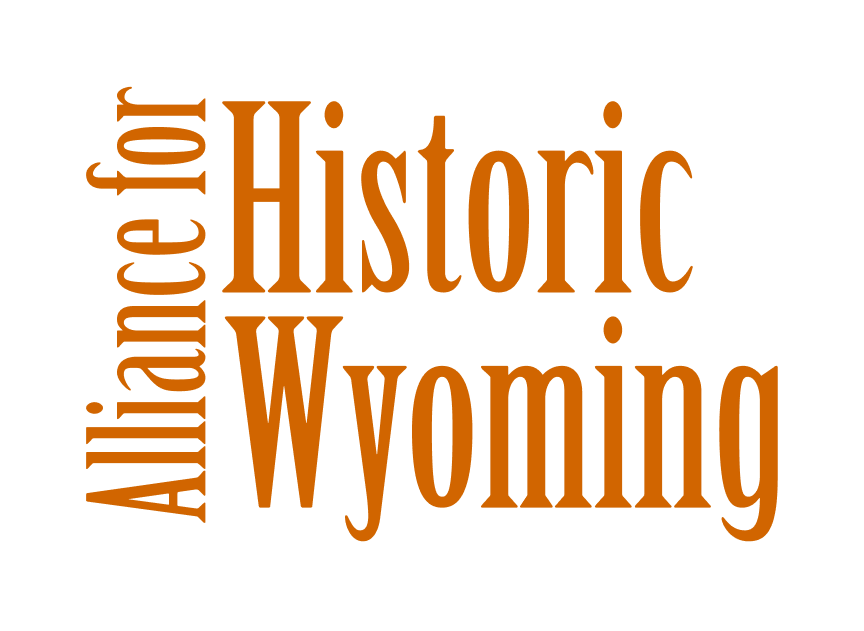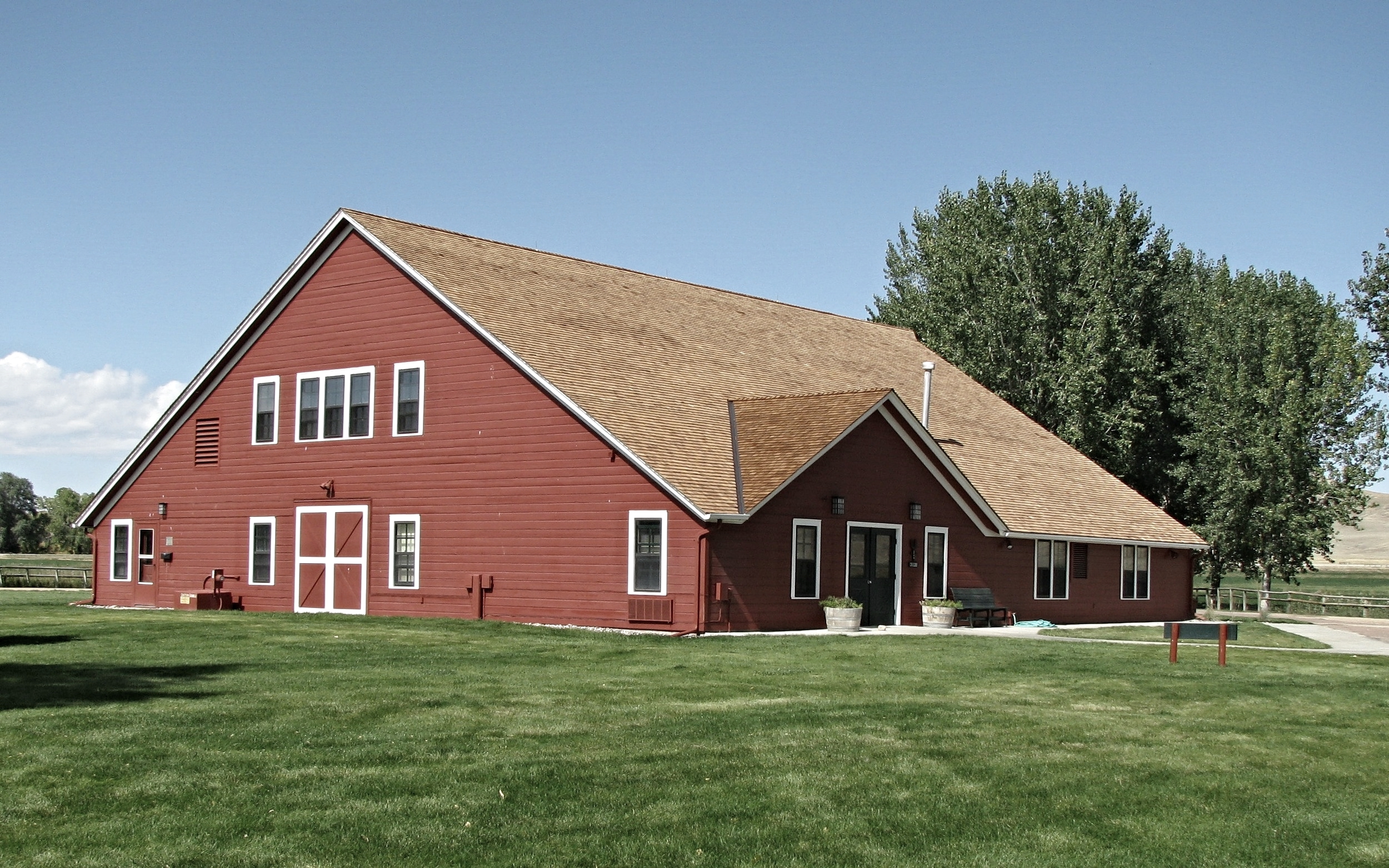BIG RED Barn
A Brief History of the Ucross Ranch and Nearby Buildings
Text courtesy Ucross Foundation
June 15, 2016
In Wyoming Territory in 1878 towards the close of the Indian Wars, the Pratt and Ferris Cattle Company was incorporated by four partners: James H. Pratt (born in Massachusetts in 1825, Pratt rose to the rank of Colonel in the Civil War and went on to be appointed Post Trader at Fort Randall in Dakota Territory in the 1870’s), his brother-in-law Cornelius Ferris, Marshall Field of Chicago (of the famed department store), and another brother-in-law of Pratt.
All of the four ranches which made up the company were situated on former Indian hunting grounds, with Big Red and Big Corrals in Powder River Basin on Sioux bison hunting grounds. Two of the four ranches were in Goshen County, the PF on the Platte River near the Nebraska line and the Upper PF on Rawhide Creek. Big Red and Big Corrals (a few miles east of Clearmont) were in what was then Johnson County but is now Sheridan County. The village of Ucross that settled around Big Red went through several name changes, including Cedar Rapids (which it was known as in 1913), Dow, Charger and finally Ucross, after the original Pratt and Ferris brand.
 Photo courtesy Ucross Foundation
Photo courtesy Ucross Foundation
Big Red became the headquarters for all four ranches sometime in the 1880’s. The Ranch House is one of the oldest standing houses in the area. Construction on the house and the Big Red Barn began in 1882. Among the house’s many modern features was a bathroom with hot and cold running water. A copper-lined wooden tank in the attic furnished the water pressure. From 1886 to 1902, a fourth-class post office was operated at Big Red to serve the ranch and neighboring settlements. Big Red was also on the stagecoach route that serviced Buffalo to Clearmont during the years 1891 to 1911. Old timers refer to that service as the BCB Railroad: “Buffalo to Clearmont and Back.”
In the 1890’s, Marshall Field sold his shares in Pratt and Ferris to his former Chicago partner, Levi Leiter. Chicago real estate and the department store had made Leiter a wealthy man. He was a sharp-minded, astute businessman and he became the dominant partner in the cattle company, holding 2,914 of the 4,000 shares (more than twice as many as Colonel Pratt’s 1,086 shares). He exercised a great deal of management and financial authority over the affairs of all four ranches but he never visited any of them in person. During the late 1890’s Leiter and Pratt bought out the other stockholders in the Pratt and Ferris Cattle Company and they became its sole owners. In the year 1900 the company ran 3,500 cattle on the two Platte River ranches and 13,000 on the Big Red and Big Corrals ranches.
Levi Leiter hired William C. (“Billy”) Irvine in the spring of 1903 as the manager for all four ranches. He headquartered at Big Red until leaving in 1905 or 1906. Under Irvine the ranch switched from running cattle to running sheep. Leiter died in the summer of 1904 and his widow, daughters and only son Joseph inherited all of his shares of the Clear Creek holdings (including Big Red and Big Corrals) as well as some property at the site of the Upper PF near Lingle, Wyoming. His son assumed management of the ranches. Leiter’s will stipulated that the estate could not be divided until the last of his children had died. Joe Leiter ran Big Red and Big Corrals and his interest was focused on the most advanced irrigation techniques and farm crops rather than cattle or sheep. He was a major force behind the Lake DeSmet Water Project, the second Kearney Lake Company, and other irrigation projects that still serve the crop lands of the valley today.
Colonel Pratt died in 1910. Gradually, the properties were divided into individual tenant farms and leased to many of the Russian-German immigrants who had come west. This tenant “project” was called the Leiter Estates, and most of the farmers grew sugar beets. Joe Leiter began the negotiations with Holly Sugar to construct the Sheridan mill, which was ready by 1916 for local crops. Leiter put his energy and the company’s money into expanding the irrigation and farming and by 1921 over 6,000 acres of Big Red and Big Corrals were under irrigated cultivation.
A sagging market combined with labor and capital demands and other factors led to a general decline in Wyoming’s farm economies, culminating in the failure of the Clearmont bank. Shortly thereafter, Joe left for Chicago and had little to do with the properties after 1926. The Great Depression set in and from 1929 to around 1949, the Clear Creek valley ranches operated in sporadic fashion.
In 1949 Leiter Estates sold all of the Clear Creek holdings known as Big Red and Big Corrals to Sheridan rancher John Rice. Rice was killed on a flight to Australia and his widow sold off the small farm units originally farmed by the tenants. Alex Pitsch purchased Big Red, where his family had once been tenants, and ran the property for many years. Alex and Leora Pitsch were married at Big Red Ranch House.
In the mid 1960’s the Pitsch property was purchased by Apache Corporation which also began to acquire other parcels originally part of the Big Red Pratt and Ferris complex on Clear Creek. Apache Corporation donated Big Red and approximately 250 acres surrounding the buildings to the Ucross Foundation, a public non-profit organization incorporated in Wyoming on June 1, 1981. The funds were raised to restore the Big Red Barn and the Ranch House. The Big Red Ranch Complex is on the National Register of Historic Places and can be toured by the public Monday-Friday from 8:30 a.m. to 4:00 p.m. The Big Red Barn now houses an art gallery, a loft space for conferences and a grand piano for performances, while the Big Red Ranch House is home to the administrative offices of the Ucross Foundation.  The old house now serves as offices for the foundation. Photo courtesy Ucross Foundation
The old house now serves as offices for the foundation. Photo courtesy Ucross Foundation
The balance of the property became part of the Ucross Foundation in 1994. It continues as a working cattle ranch today, leased by the Apache Foundation and sub-leased to Bauer Land and Livestock which operates the cattle ranch according to holistic resource management practices. In 1999, a conservation easement, held by the Wyoming Chapter of The Nature Conservancy, was placed on more than half of the 20,000-acre Ucross Ranch. In 2015, the Ucross ranch was designated an Important Bird Area by Audubon. A nearby salvage yard has been transformed into a community park that features a small chapel and the Raymond Plank Creative Center.
The mission of Ucross Foundation is to foster the creative spirit of deeply committed artists and groups by providing uninterrupted time, studio space, living accommodations, and the experience of the majestic High Plains while serving as a good steward of its historic 20,000-acre ranch. Ucross believes that being a good steward of the land closely resembles being a good artist, and vice versa. Both require dedication, imagination, and the best possible use of the resources at hand.
The nearby Depot, formerly a Burlington Northern train depot, was relocated from Clearmont to Ucross in 1991 and now houses four resident artists, with studio space for two writers. The Ucross School House, built in 1914, houses four residents as well as the main dining room and kitchen serving the resident artists. In 2016, the Foundation plans to embark upon a capital campaign to renovate the School House in order to enlarge its dining and kitchen facilities. The goal is to better support the nearly one hundred individuals who spend time as Ucross artists-in-residence each year. Construction is expected to take place in summer 2017.
A recipient of a Wyoming Governor’s Arts Award for Excellence in the Arts, the Ucross Foundation has provided nearly 2,400 residencies to artists, writers, composers and choreographers from across the United States and the world. A number of residents have gone on to win the Pulitzer Prize, the National Book Award, the Tony Award, the Guggenheim Fellowship, the MacArthur Fellowship, and many other honors.
The Big Red Barn now houses an art gallery. Photo courtesy Ucross Foundation
In addition to fostering the work of individual artists, Ucross is a meeting and working place for groups, a multi-disciplinary laboratory for creative thinking. The Foundation helps to sponsor and host educational programs, conferences, and special events at the public art gallery, which is one of the cultural landmarks of northern Wyoming. Ucross Foundation’s reach is as close as its nearest neighbors and as distant as almost any spot on earth. Ucross is home to the creative spirit.
LIKE WHAT YOU JUST READ?
- Browse our archive of Historic Places and Spaces Profiles by clicking here.
- To learn about all of our campaigns and initiatives, click here.
- Subscribe to our newsletter to learn more about what’s going on in Wyoming.
- Donate or become a member to help us produce stories, organize events, and be a voice for preservation across the state.
- Like us on Facebook, and follow us on Twitter and Instagram to see our latest updates!



